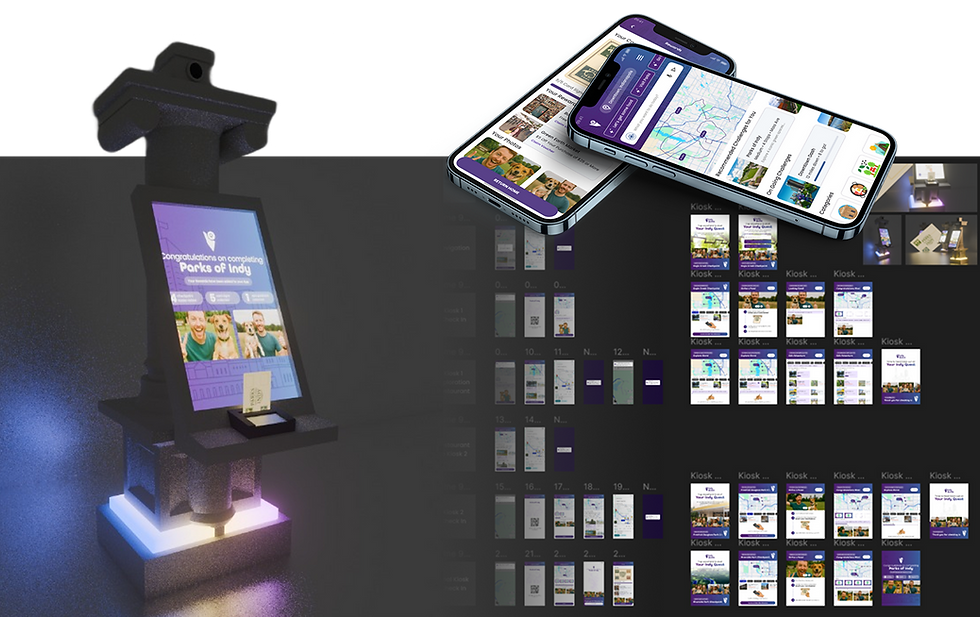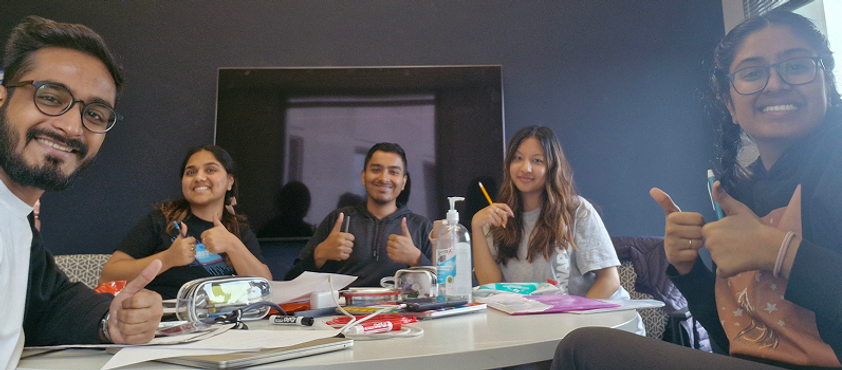
Designing a Gamified Exploration Experience for the City of Indianapolis
UX Design · Prototyping · 3D Modeling · Hybrid Systems

PRODUCT OVERVIEW
IndyQuest is a hybrid system designed to encourage exploration in Indianapolis through themed quests. The experience combines kiosks, collectible postcards, and an app to make city discovery playful, intentional, and memorable.
TIMELINE
2 Months
ROLE
-
UX Designer leading kiosk and postcard interactions in a team of 5 members
-
Created 3D prototypes in Blender and co-defined the app flow.
-
Conducted usability testing, driving a key pivot from custom navigation to Google Maps integration.
TOOLS
Figma, Blender, Sora
PROBLEM
Exploring Indianapolis often feels accidental. Most newcomers stick to familiar spots like Mass Ave or the Canal, bouncing between apps to plan a simple outing.

From desk research, competitive analysis, and user interviews, several core patterns emerged:
-
Exploration is accidental: People stumble into events or restaurants rather than plan ahead.
-
Tools are fragmented: Users juggle 4–5 apps just to plan a simple outing.
-
Navigation isn’t delightful: Apps get you from point A to B, but miss everything in between.
-
Physical keepsakes matter: A receipt fades, but postcards, photos, and stamps become memorable tokens.
THE USERS
Our research focused on 3 types of explorers. Each persona captured unique goals, frustrations, and motivations that shaped the solution.

Through interviews, surveys, and cultural probes, we identified three types of explorers in Indianapolis, translating interview insights into detailed personas and journey maps. These artifacts helped us map emotional highs and lows, pain points, and opportunities across the exploration journey.

OUR VISION
Based on what we learned, we asked ourselves: what if exploring Indianapolis felt less like searching and more like playing a game?
Our idea, IndyQuest, reimagines the city as a set of themed quests that combine kiosks, collectible postcards, and a mobile app into one cohesive, hybrid experience. Our core concept revolves around 3 key ideas:

Quest-Based Exploration: Users embark on user-generated and curated themed trails like “Parks of Indy” or “Street Art,” turning city discovery into purposeful adventures.

Hybrid Touchpoints: Postcards, kiosks, and the mobile app work together, creating a seamless bridge between physical and digital exploration.

Rewarding Progress: Players collect physical stamps on their postcards and collect signatures from local businesses, making exploration both fun and memorable.
To ground our vision, we drew inspiration from existing systems that successfully blend physical and digital exploration. Exemplars like Pokémon GO and the Indy Cultural Trail helped shape IndyQuest’s quest and kiosk system.

With this vision in place, our next step was to translate the concept into designs through iterative prototyping and testing.
THE PROCESS

We followed an iterative process through discovery, design, and testing with each stage shaped by direct user feedback.
Leveraging our research, We sketched flows for kiosks, postcards, and the mobile app, exploring different ways physical and digital touchpoints could work together. The goal was to ensure that as users moved through each phase, it felt like progressing through a game, collecting souvenirs along the way that turn their journey into a physical keep-sake.

A four-phase user journey flow which anchored design and testing across iterations
Prototyping & Testing were treated as a continuous loop. From early sketches to paper mockups, Figma flows, and high-fidelity screens, we tested three key tasks with users, gathered insights, and refined the experience at every step.

LOW FIDELITY PROTOTYPE
First, we created a paper prototype simulating interactions and tested it with 3 participants using think-aloud protocol.
-
Average Satisfaction: 3.7 / 5
-
Average Interactions: ~6.3 clicks + scans/swipes


MID FIDELITY PROTOTYPE
We then moved into Figma, designing mid-fidelity screens to define the quest flow: choosing a theme, scanning at kiosks, collecting stamps, and tracking progress.
-
Average Satisfaction: 4.2 / 5
-
Average Interactions: ~6.5 clicks + scans/swipes


HIGH FIDELITY PROTOTYPE
Finally, we refined the app into polished high-fidelity screens and modeled kiosks in Blender to visualize how physical and digital touchpoints connect.

Iterative testing shaped IndyQuest into a hybrid system that seamlessly connects kiosks, postcards, and an app, creating a purposeful, playful exploration experience for Indianapolis.
THE EXPERIENCE OF INDYQUEST
Emma is a new IU student who wants to explore the city beyond the Canal and Mass Ave. She opens IndyQuest and begins her adventure.
Step 1 - Planning
Emma opens the app, where she can either browse quests or let the AI suggest one based on time and interests. She picks “Parks of Indy” and receives a postcard at the first kiosk to track her journey.

Step 2 - Exploration
At each checkpoint kiosk, Emma checks in, collects a stamp on her postcard, and sees nearby recommendations. One kiosk highlights a local café where she stops for a signature from the owner. As Emma progresses, the app shows her route, trophies earned, and side quests unlocked. She enjoys flipping her postcard as a tactile reminder of progress while checking the app for digital rewards.

Step 3 - Completion
At the final checkpoint, Emma collects her last stamp. The app congratulates her with vouchers for local businesses, while her completed postcard becomes a personalized keepsake of her Indy adventure.

Emma’s journey shows how IndyQuest transforms city exploration into purposeful, playful, and memorable storytelling.
OUTCOMES

“You’ve developed a very thorough process. Your concept is unique and especially influential as it explores beyond walkability into the more familiar car-centric experience of this city.”
- Alex Hoffman
4.2/5
USER SATISFACTION SCORE
Users especially enjoyed the postcard stamping mechanic and hybrid kiosk-app progress. Feedback confirmed that IndyQuest made exploration feel more purposeful and rewarding compared to existing tools.
97.5%
ACADEMIC EVALUATION SCORE
Recognized for iterative rigor, storytelling depth, and comprehensive prototyping, and praised for adapting wayfinding to car-centric urban contexts, an often-overlooked dimension in city UX design.
This project taught me how to bridge physical interaction modeling with mobile UX and spatial storytelling. It deepened my ability to design across environments while maintaining a cohesive journey, a perspective I now bring to all experiential design processes.

Check out this Case Study Next!
or


